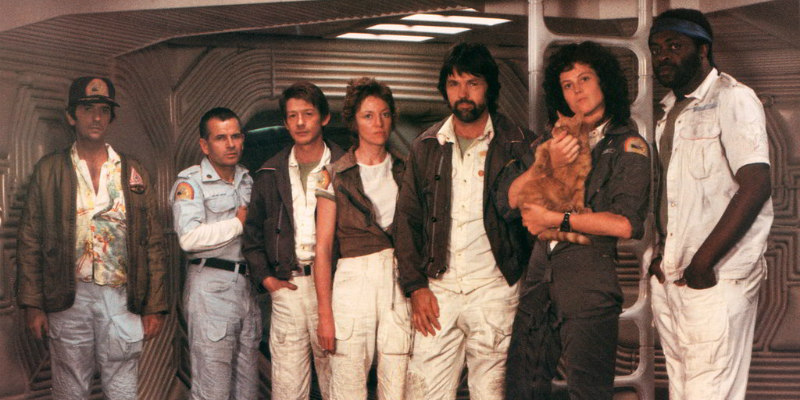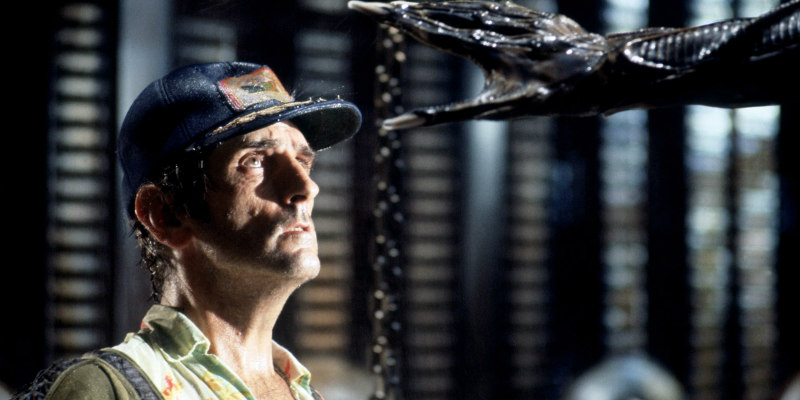
A space trucker is feeling a little chesty.
Words by Ren Zelen
Directed by: Ridley Scott
Starring: Sigourney Weaver,Tom Skerritt, John Hurt, Ian Holm, Veronica Cartwright, Harry Dean Stanton, Yaphet Kotto

“Believing the strangest things, loving the alien” David Bowie.
In 2020 it’s impossible to approach Ridley Scott’s 1979 film Alien as a first-time viewer and feel anything resembling its original impact. Everyone has seen Scott’s vision of space taken up by countless sci-fi films, and most people know each of Alien’s iconic scenes, whether they’ve seen the entire film or not.
After several Alien sequels and spinoffs, countless imitators, and the wholesale cinematic plundering of HR Giger and Scott’s visual sci-fi language, it is hard for latter generations to imagine a time in science-fiction before Alien - a time before face-huggers, chest-bursters, CGI enhancements and strong heroines - but such a time there was.


In the science-fiction movies of the 1950s, '60s and early '70s, the role of female characters was mostly confined to mixing cocktails for their scientist husbands or screaming and fainting at inconvenient moments. Women were there to be protected and rescued by the male protagonists and were usually merely adjuncts in a larger scheme of saving the world. Apart from the occasional appearance as tightly-costumed eye-candy, their role was generally as damsels in distress, helpmeets or bespectacled ‘assistants’.
As the daughter of a father with a fondness for all-sci-fi, especially old B-movies, I found Alien a revelation. I realised that after Alien in 1979, the entire ‘look’ and tone of sci-fi was forever altered and that Ellen Ripley was to become a new kind of protagonist.
Alien is one of the most discussed, dissected and academically analysed movies in modern cinema. Considering so much has been said about it, the film seems to be simplicity itself: a tense, linear storyline, an innovatively envisioned setting and sparse dialogue.
Belying its high production values and box-office success, Alien was made on a shoestring budget by Hollywood standards (approximately US$11 million). It only goes to show that creativity and imagination are more enduring than dollars. Without the benefit of CGI, Scott and the Swiss surrealist artist Giger relied on their artistic inventiveness to create an innovative and hugely influential sci-fi horror vision.
After all the shiny chrome, gleaming hardware and twinkling lights of the spaceships that came before, it was odd to see an oily, grubby, leaky, industrialised spacecraft. More shocking was a female character being allowed to finish a movie as the sole survivor. I’d never seen that happen in the sci-fi movies my dad used to watch - just as I’d never seen that outstanding Giger visualisation, the Xenomorphic alien (for which he won an Oscar).
[ READ MORE: The Films That Made Me - The Marx Brothers' Duck Soup ]
[ READ MORE: The Films That Made Me - The Marx Brothers' Duck Soup ]
We have become so familiar with the ‘Alien’ of the title, most viewers don’t now realise when watching the original movie that the creature is never seen properly until the last few shots. (We didn’t see Giger’s creation in its full glory until James Cameron’s action sequel, Aliens.)
Having been a huge science-fiction story fan since my teens, I understood it as a genre predicated on the exploration of the bizarre, fantastic and unusual, a genre most closely connected to the imagination and to dreams. Despite its apparent simplicity, Alien tapped into some deep psychological territory, and this is another reason why its resonance is still felt throughout popular culture.


The film began with the camera exploring the inner-space of the mother-ship, tracking down a corridor to a womb-like chamber which houses the crew, wakened from a protracted sleep by the craft’s support-system, aptly named ‘Mother’.
The waking of the crew mirrors a kind of rebirth, but they emerge into a clean, antiseptic, white-walled ambience – well-controlled and regulated. There is no blood, trauma or pain here. Contrast this with the mysterious, dark, dank, organic interior of the crashed ship three of the crew are later required to enter through vulvic-like openings.
[ READ MORE: The Films That Made Me - Alfred Hitchcock’s Rear Window ]
[ READ MORE: The Films That Made Me - Alfred Hitchcock’s Rear Window ]
Crew member Kane (John Hurt) is lowered into a dark, steamy chamber housing rows of eggs, the most basic of organic forms. As his hand touches one of the leathery eggs it opens up, revealing a fleshy, pulsating interior. A hand-like thing inside leaps out, smashes through his helmet, and a snake-like protuberance penetrates through Kane’s mouth and throat – reaching deep inside him in order to fertilise itself within the secure confines of his stomach.
Many of our primal fears are invoked – the fear of suffocation, of forced penetration and of unwanted pregnancy, and just for good measure, this invasive violence and subsequent gestation is perpetrated upon a man. The Alien is not fussy about whom it impregnates, males are just as useful.
The now well-known scene of Kane’s bloody birthing of the Alien ‘baby’ was originally one of the most jolting cinematic ambushes in cinema history. It begins innocently enough, with Kane apparently recovered and the Nostromo circle happily reunited over dinner – but it ends with Kane convulsing in agony, being held down by his unwitting crew-mates, when, with a cracking of rib-bones and a spray of blood and entrails, the Alien infant gnaws and bursts its way out of his torso, hisses at the stupefied, gore-splattered crew, and scurries out of sight.
The invasive ‘alien’ penetrates and violates the human body, bursting through its flimsy organic matter and likewise through the barriers of sexual identity – and its birth is death. On the film’s first release cinema-goers were just as shocked as the crew - in space, apparently, ‘no-one can hear you scream’.


Probably the bravest twist in that original Alien movie was to fly in the face of all the cinematic expectations of the '70s and kill off the central character of the rugged, manly captain (Tom Skerritt) mid-narrative. Then, to allow an attractive woman to be the tenacious survivor when no-one at the time would have expected Ellen Ripley to take on the role of monster vanquisher (and yes, unsurprisingly, her role was initially written for a man).
In that first movie Ripley emerged gradually from an ensemble cast to be the focus of identification – the perceptive and resourceful survivor. Even more unusually, Sigourney Weaver’s character was to become the connecting thread that was to run through all the Alien sequels, making it the first movie series to be focussed on and powered by a female protagonist. It made an international star of Weaver and of the Xenomorph she managed to escape (against all cultural odds of the time). We would never see space travel the same way again.
"A piece of demented trash that simultaneously displays a high level of filmmaking technique."— 𝕋𝕙𝕖 𝕄𝕠𝕧𝕚𝕖 𝕎𝕒𝕗𝕗𝕝𝕖𝕣 (@themoviewaffler) March 18, 2020
BEYOND THE DOOR is on blu-ray March 30th from Arrow Video.
Read @hilliseric's reviewhttps://t.co/19uRqdWNog pic.twitter.com/F7pEZGceZU
